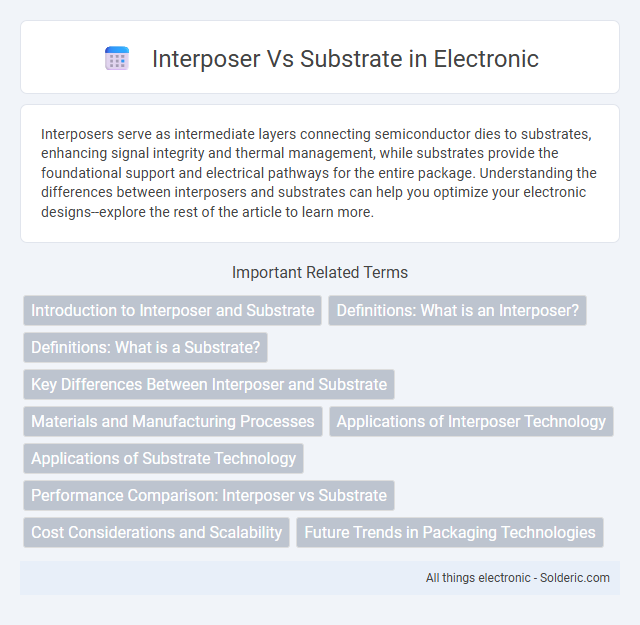Interposers serve as intermediate layers connecting semiconductor dies to substrates, enhancing signal integrity and thermal management, while substrates provide the foundational support and electrical pathways for the entire package. Understanding the differences between interposers and substrates can help you optimize your electronic designs--explore the rest of the article to learn more.
Comparison Table
| Feature | Interposer | Substrate |
|---|---|---|
| Definition | Intermediate layer for chip connection, often silicon-based | Base layer for mounting and connecting semiconductor components |
| Material | Silicon, glass, or organic materials | Organic laminates, ceramics, or fiberglass |
| Function | Facilitates high-density interconnects between chips (e.g., 2.5D/3D packaging) | Provides mechanical support and electrical routing for components |
| Use Case | Advanced packaging solutions requiring high bandwidth and low latency | Standard printed circuit board substrate applications |
| Cost | Higher due to complex fabrication | Lower, mass-produced substrate technology |
| Performance | Enables enhanced signal integrity and thermal performance | Supports general electrical and mechanical integrity |
Introduction to Interposer and Substrate
Interposers and substrates serve as critical components in advanced semiconductor packaging, enabling complex integration of chips. An interposer acts as an intermediate layer with fine wiring, facilitating high-density interconnections between dies, often used in 2.5D ICs to optimize signal integrity and power delivery. Substrates provide mechanical support and electrical pathways for the entire package, connecting the chip to the printed circuit board (PCB) while managing thermal and electrical performance.
Definitions: What is an Interposer?
An interposer is a thin intermediary layer used in semiconductor packaging to connect multiple integrated circuits or components, enabling high-density interconnections and enhanced electrical performance. It acts as a bridge, redistributing signals between chips and the substrate, often utilizing through-silicon vias (TSVs) for vertical connectivity. Your choice between an interposer and a substrate depends on factors like design complexity, signal integrity requirements, and manufacturing costs.
Definitions: What is a Substrate?
A substrate is a foundational layer in semiconductor packaging that supports and electrically connects the integrated circuit to the printed circuit board through multiple conductive pathways. It typically consists of organic or ceramic materials designed to provide mechanical stability and thermal dissipation. Substrates facilitate signal routing, power delivery, and heat management, making them essential for high-performance electronic devices.
Key Differences Between Interposer and Substrate
Interposers serve primarily as electrical pathways for connecting dies in 3D integrated circuits, typically fabricated from silicon or glass to provide high-density interconnections and signal integrity. Substrates function as the foundational support structure for semiconductor packages, offering mechanical stability, heat dissipation, and routing of signals to the printed circuit board, and are commonly made from organic materials like epoxy resin or BT resin. The key differences lie in their material composition, functional purpose, and integration approach, where interposers enable fine-pitch die-to-die connections in advanced packaging, while substrates support the overall package and interface with external circuitry.
Materials and Manufacturing Processes
Interposers are typically made from silicon, glass, or organic materials, utilizing semiconductor fabrication techniques like photolithography and wafer bonding, enabling high-density interconnections for advanced packaging. Substrates often use organic laminates such as FR4 and BT resin, manufactured through multilayer lamination, etching, and plating processes tailored for reliability and cost-effectiveness in PCB applications. Understanding the distinct materials and manufacturing methods is crucial for selecting the right component that optimizes your device's electrical performance and thermal management.
Applications of Interposer Technology
Interposer technology is widely used in high-performance computing, advanced packaging, and multi-chip modules to enable efficient integration of heterogeneous components and improve signal integrity. Applications include chiplets integration, 2.5D and 3D packaging, where interposers act as an intermediate layer providing high-density routing and thermal management. Industries such as data centers, AI accelerators, and mobile devices leverage interposers to enhance bandwidth, reduce latency, and optimize power consumption.
Applications of Substrate Technology
Substrate technology is widely applied in advanced semiconductor packaging, including System-in-Package (SiP) and Chip Scale Package (CSP) solutions, due to its ability to provide mechanical support and electrical interconnections. It enables high-density interconnects and enhances thermal management, making it ideal for mobile devices, automotive electronics, and high-performance computing. Your choice of substrate technology significantly impacts the overall device reliability and signal integrity in these applications.
Performance Comparison: Interposer vs Substrate
Interposers typically offer superior electrical performance due to shorter signal paths and lower parasitic capacitance compared to substrates, enhancing high-frequency signal integrity and reducing latency. Substrates, while more cost-effective, may introduce greater signal loss and thermal challenges, impacting overall device performance in advanced semiconductor packaging. Your choice between interposer and substrate should consider the specific performance requirements, including signal speed, power efficiency, and thermal management.
Cost Considerations and Scalability
Interposers generally incur higher manufacturing costs due to complex materials like silicon and advanced processes required for through-silicon vias (TSVs), whereas substrates utilize less expensive organic materials, resulting in lower initial expenses. Scalability favors substrates because their established fabrication techniques support larger volumes with consistent yields, while interposers face challenges scaling up due to intricate design and limited wafer sizes. Cost-effective mass production typically leans toward substrates, especially in applications where incremental electrical benefits of interposers do not justify their elevated price points.
Future Trends in Packaging Technologies
Future trends in packaging technologies emphasize increased adoption of advanced interposers and substrates for enhanced semiconductor integration. Silicon interposers continue to evolve with higher bandwidth and lower latency improvements, while organic substrates advance in cost-effective, high-density 2.5D and 3D packaging solutions. Emerging innovations such as heterogeneous integration and chiplet-based architectures drive the demand for substrates and interposers that support fine-pitch interconnections and superior thermal management.
Interposer vs Substrate Infographic

 solderic.com
solderic.com